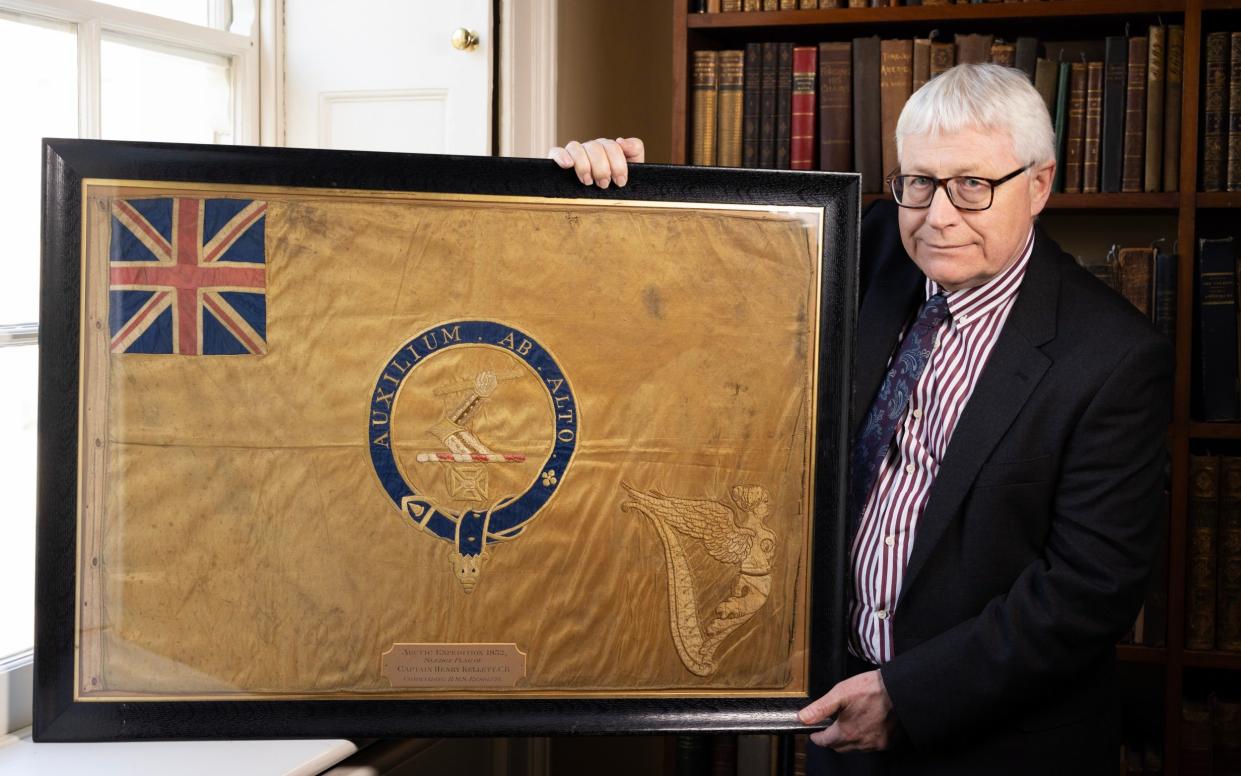Museum begs nation to save Arctic expedition flag which is ‘piece of naval history’

- Oops!Something went wrong.Please try again later.
It is a relic of the darkest chapter in the history of British polar exploration, and a symbol of selfless heroism in the most inhospitable of lands.
As Captain Henry Kellett and his men scoured the Arctic wilds between 1852 and 1854 in an attempt to discover the fate of HMS Terror and HMS Erebus and their 129-strong crew, they flew a silk flag from his sledge bearing his family crest and the motto Auxilium Ab Alto, which translates as “help from on high” in Latin.
The personalised sledge flags were flown by Victorian polar explorers in a chivalric tradition adopted from medieval knights. The Kellett flag is not only one of half a dozen or so believed to be in existence, but it is also one of the earliest known still in existence.
But despite its unique place in British maritime heritage, it is feared the Kellett flag is about to be lost to the nation for good after it was sold to a US buyer.
The Government has imposed a temporary export bar until Dec 1 on the sale of the flag and granted the National Museum of the Royal Navy a two-week window to match the fee of £120,000 in order to keep it in Britain and put it on public display.
The likes of Michael Palin and historian Dan Snow have backed the fundraising appeal, which launches on Monday and runs until March 19.
Mr Palin describes the flag as “an emblem of survival and heroism in the most appalling circumstances” and “an inspirational piece of naval history which should be kept for all to see so that the story of the brave men who flew it is never forgotten”.
Captain Henry Kellett was born in Tipperary, Ireland, in 1806 and joined the Navy in 1822. He made his name in the Opium War in the early 1840s and was later recruited to help discover the fate of HMS Terror and HMS Erebus.
Both ships commanded by Sir John Franklin had sailed from England in 1845 in an attempt to search for the Northwest passage but had vanished along with all 129 men on board.
The ships have only been recently discovered by Canadian researchers in 2014 and 2016. As Franklin's men succumbed to starvation and scurvy while trapped on the ice it is thought they resorted to cannibalism to stay alive.
The rumours shocked Victorian high society and were dismissed by Charles Dickens who claimed even in their desperation they would never have resorted to such “dreadful” actions.
However, recent forensic analysis of some remains of the crew has revealed bones scraped clear of marrow and skulls cleaved open in order to reach the brains.
“Clearly people were trying to escape from the ship and were in desperate straits and so it is not unlikely,” said Dominic Tweddle, director general of the National Museum of the Royal Navy.
Kellett was captain of HMS Resolute, one of a number of ships dispatched to the far north to help recover the doomed expedition. He too narrowly avoided a similar fate to Franklin when in late 1853 Resolute became trapped on the ice and his men were forced to abandon ship.

Kellett led his men across the ice to safety, reaching Beechey Island where they were rescued.
Eventually, HMS Resolute was retrieved by an American whaling boat. The US government then purchased and refitted the ship before sailing her back across the Atlantic as a gift to Queen Victoria.
In return, when Resolute was decommissioned and broken up in 1879, her timbers were used to create a desk for the US President which still sits in the Oval Office today.
After commands in the West Indies and China and reaching the rank of admiral, Kellett returned to Ireland where he died in 1875.
The flag has remained in his family’s possession ever since, passing to Diana Kellett, the daughter of his descendant Colonel Edward ‘Flash’ Kellett who was killed in the Second World War.
Ms Kellett later married the Conservative minister and peer Lord Holderness who kept the flag in the hallway of their Yorkshire home. It is being sold by their son, Ed Wood, a 71-year-old entrepreneur and chartered accountant.
He told The Telegraph that the family wanted to sell the flag so it could reach a wider audience and were backing the campaign for it to remain in Britain.
The Art Fund has already contributed £40,000 to the appeal which has been match-funded by the National Museum of the Royal Navy. It is hoped the remaining £40,000 will come from public donations.
Donations can be made at donate.nmrn.org.uk

